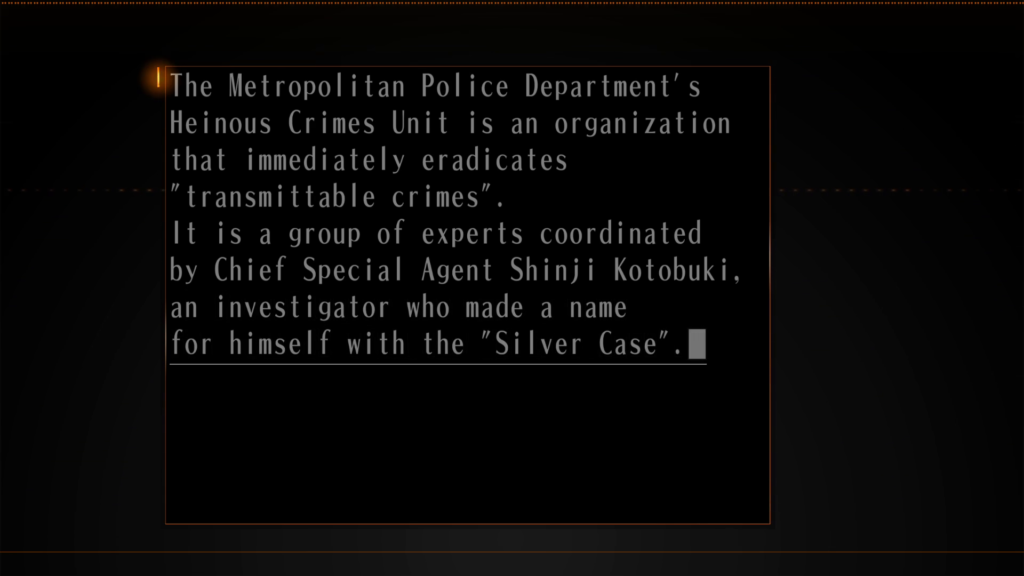Chapter 2: Five Kamuis
Fundamentally, what is The Silver Case about? Melos Han-Tani, one of the creators of Anodyne and Even the Ocean, put it well in a tweet: “A timely game on social control, politicians working against the public, information/trends spreading through social networks.” More specifically, The Silver Case is about political organizations manipulating information as a form of social control to act against public interest. As we have seen, “truth” and “facts” are different. Different interest groups distort “facts,” pieces of real information, into “truths” that cherry pick, conceal, and lie about “facts” to serve sinister political ends. Information is so influential in The Silver Case that, according to the opening, “The most striking source of conflict” between the upper and lower classes of Kanto is not the expanding wealth disparity but “discord between those with easy access to information and those without.” The history on the official Silver Case website is clear that the sense is the poor have little access to information, while the rich have a large amount of access to information. That is, the poor have less access to “facts.”

Under the guise of “public safety,” the Heinous Crimes Unit kills and arrests elements of the population that Nezu, through a chain of algorithms and bureaucrats, deems unsuitable. In this way, the government/mayor/Nezu asserts “absolute control” over the public. However, the opening text of “Lunatics” explicitly states that this specialized police force’s role is the containment not of criminals per se but of information. This information is “transmittable crimes” or “criminal power,” what Kusabi, in “Lunatics,” calls a “crime virus.” Hachisuka Chizuru says, “Even if the body is destroyed, the crime virus that’s been spread by Kamui lives in the information people possess.” However, it is as accurate to say that Kamui is himself the crime virus as that Kamui spreads it. The most prominent and consistent form of the “information” or “virus” is Uehara Kamui.
Kamui/Ayame refers to various specific characters in the universe of The Silver Case and its sequels, such as Fujiwara Kamui, Morishima Tokio, and Natsume Sakura. However, and just as important, the “crime virus” is not contagious irrational violence (though it might be, in the lowest order of “facts”) but the information associated with Kamui: who he is, what he does, and what he wants. Nic Freeman observes, “[Kamui] is no longer a person, but an event” (67). The transmission and reinterpretation of these narratives and incidents online, in the media, and between individual characters, focalized in the sinister propaganda nexus of the TTV Station Tower where the Silver Case occurred and where Nezu continues to manipulate information to enslave the public for ELBOW, is the reason the Akira chapter is titled “Transmitter.”

I locate five main “Kamuis” being transmitted in The Silver Case. The first is the person involved in the version of the Silver Case of 1979 attested in the official “truth” and discussed in the opening of “Lunatics,” the first half of “Decoyman,” “YUME,” and somewhat elaborated on in “KamuiDrome.” This Kamui is a bloodthirsty monster who assassinates the TRO/CCO chairman in 1979. The second Kamui is the tragic artist Fujiwara Kamui institutionalized at IMM Hospital. The third is the robot-like FSO assassin Format Kamui who is brainwashed, deceived, or willingly obedient to a point of acting on behalf of the powerful against his own interests. The fourth is a Kamui that exists as an antiestablishment entity seeking revenge for what was collectively done to the children in the Triangle Towers (a set of shelters), whether as an ideology, idea, or literal supernatural being, and includes the player characters, Akira and Morishima Tokio. The fifth Kamui is the innocent civilian Uehara Kamui of “Danwa,” who might be Akira and also might be the man called Uehara Kamui present in The 25th Ward.
Dividing Kamui into five narratives is somewhat arbitrary. One could as easily conceptualize eight Kamuis, as Piechota does, or any other number. Not always mutually exclusive, these categories blur at their edges. As an occult power, Kamui defies simple categorization. Five is simply a number to facilitate discussion.
The storylines of Transmitter and Placebo follow a narrative pattern of beginning with the “truths” and revealing gradually higher, more complete orders of “facts,” as with the HC Unit becoming increasingly unsympathetic and the criminals switching from lone killers to increasingly broader societal issues the police are less equipped to respond to. Placebo itself often offers higher orders of “facts” than the corresponding Transmitter cases. These other story threads parallel the “five Kamui” narratives revealing successively more of the “facts” behind the “truth,” culminating in the final revelation, Kusabi’s second explanation of the Silver Case in “Danwa” that precedes the credits, that sets the stage for the new age. In this way, The Silver Case also has the perspective begin with that of the public, who lack information, and move into increasingly deeper recesses of information that “LifeCut” reveals many more powerful characters, such as Daigo and Munakata, knew all along.